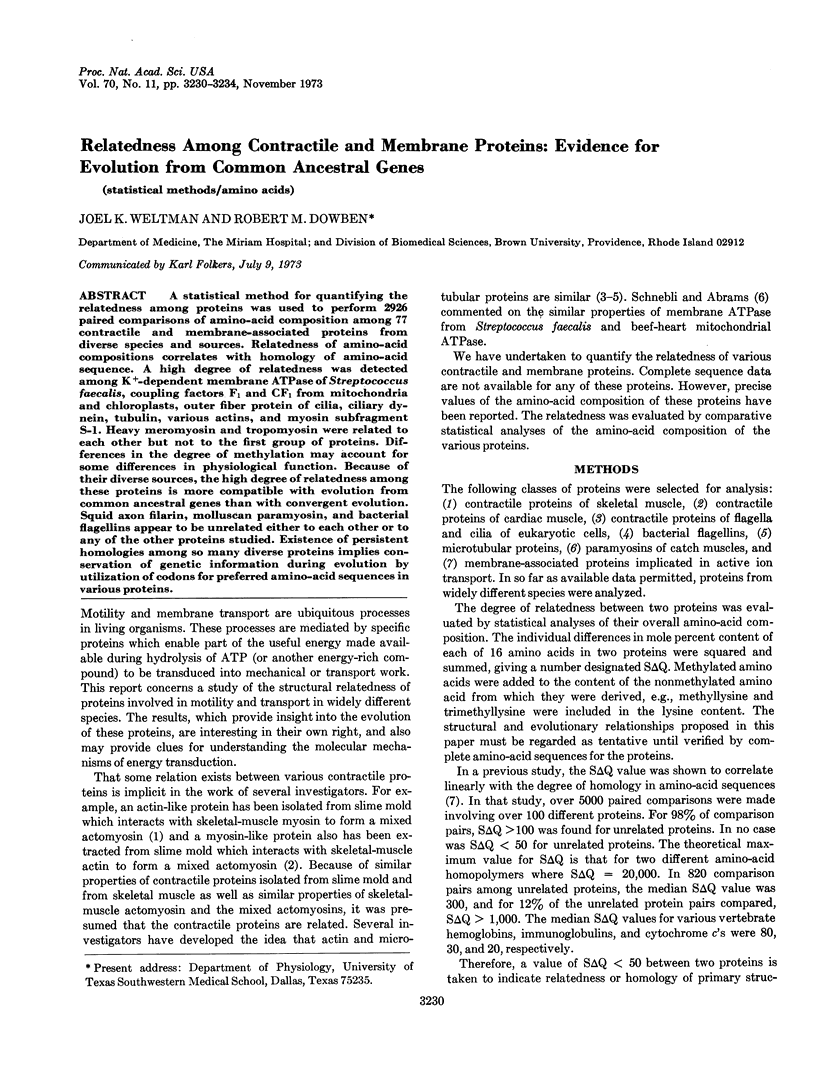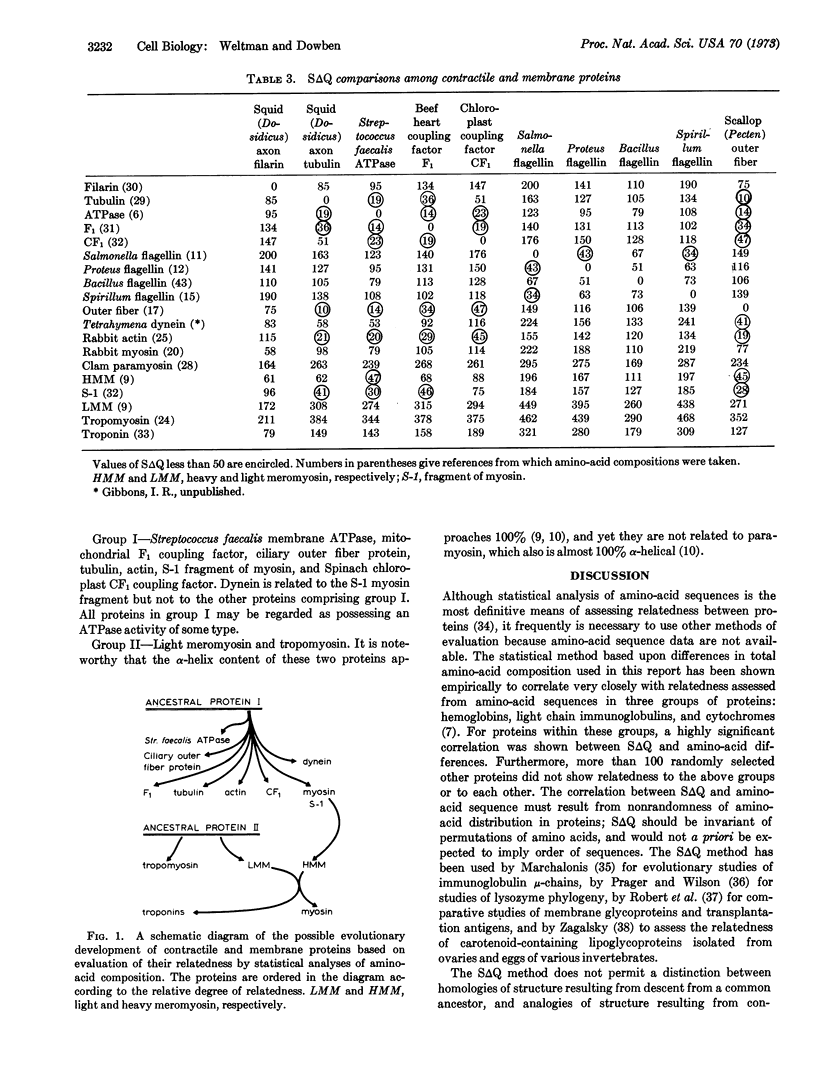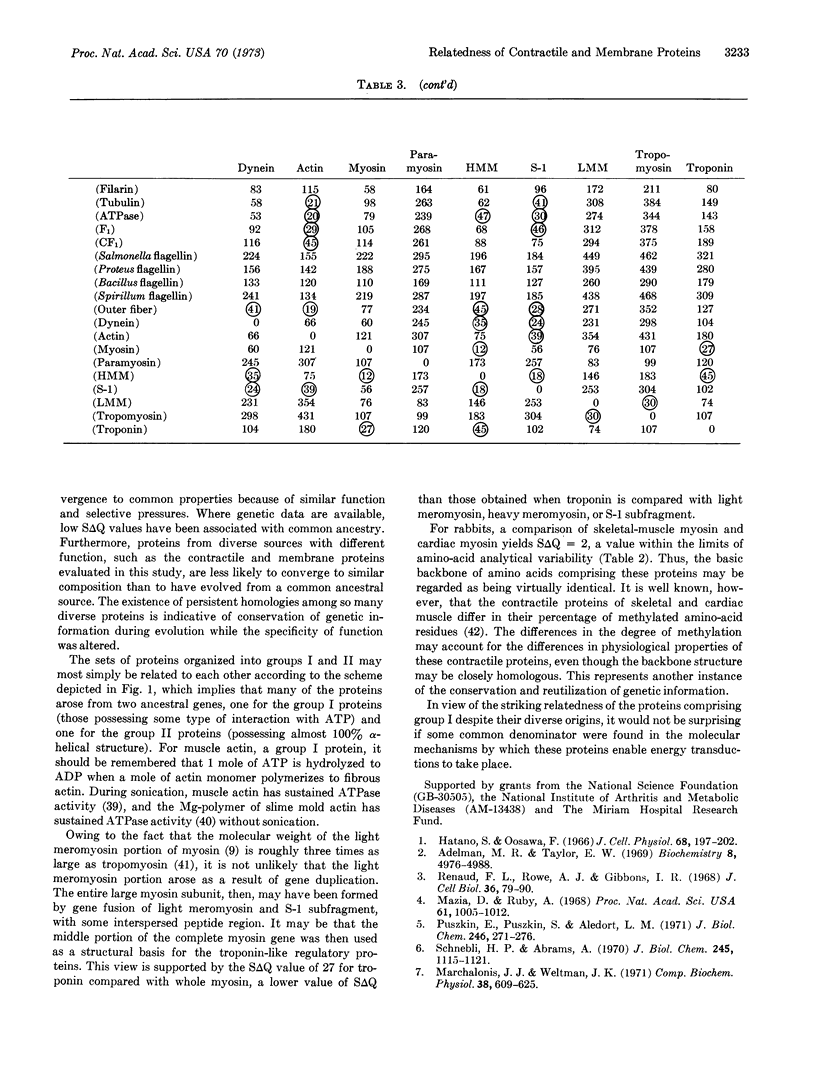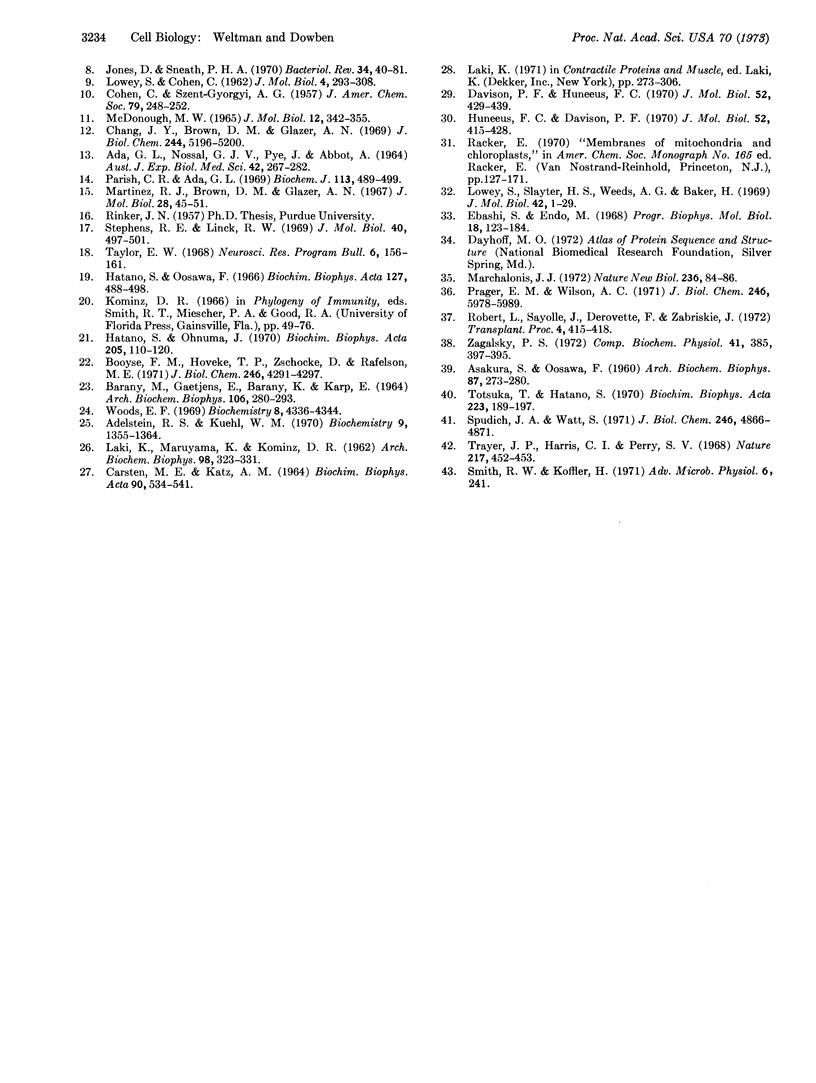Abstract
A statistical method for quantifying the relatedness among proteins was used to perform 2926 paired comparisons of amino-acid composition among 77 contractile and membrane-associated proteins from diverse species and sources. Relatedness of amino-acid compositions correlates with homology of amino-acid sequence. A high degree of relatedness was detected among K+-dependent membrane ATPase of Streptococcus faecalis, coupling factors F1 and CF1 from mitochondria and chloroplasts, outer fiber protein of cilia, ciliary dynein, tubulin, various actins, and myosin subfragment S-1. Heavy meromyosin and tropomyosin were related to each other but not to the first group of proteins. Differences in the degree of methylation may account for some differences in physiological function. Because of their diverse sources, the high degree of relatedness among these proteins is more compatible with evolution from common ancestral genes than with convergent evolution. Squid axon filarin, molluscan paramyosin, and bacterial flagellins appear to be unrelated either to each other or to any of the other proteins studied. Existence of persistent homologies among so many diverse proteins implies conservation of genetic information during evolution by utilization of codons for preferred amino-acid sequences in various proteins.
Keywords: statistical methods, amino acids
Full text
PDF




Selected References
These references are in PubMed. This may not be the complete list of references from this article.
- ADA G. L., NOSSAL G. J., PYE J., ABBOT A. ANTIGENS IN IMMUNITY. I. PREPARATION AND PROPERTIES OF FLAGELLAR ANTIGENS FROM SALMONELLA ADELAIDE. Aust J Exp Biol Med Sci. 1964 Jun;42:267–282. [PubMed] [Google Scholar]
- ASAKURA S., OOSAWA F. Dephosphorylation of adenosine triphosphate in actin solutions at low concentrations of magnesium. Arch Biochem Biophys. 1960 Apr;87:273–280. doi: 10.1016/0003-9861(60)90172-7. [DOI] [PubMed] [Google Scholar]
- Adelman M. R., Taylor E. W. Further purification and characterization of slime mold myosin and slime mold actin. Biochemistry. 1969 Dec;8(12):4976–4988. doi: 10.1021/bi00840a047. [DOI] [PubMed] [Google Scholar]
- Adelstein R. S., Kuehl W. M. Structural studies on rabbit skeletal actin. I. Isolation and characterization of the peptides produced by cyanogen bromide cleavage. Biochemistry. 1970 Mar 17;9(6):1355–1364. doi: 10.1021/bi00808a009. [DOI] [PubMed] [Google Scholar]
- BARANY M., GAETJENS E., BARANY K., KARP E. COMPARATIVE STUDIES OF RABBIT CARDIAC AND SKELETAL MYOSINS. Arch Biochem Biophys. 1964 Jul 20;106:280–293. doi: 10.1016/0003-9861(64)90189-4. [DOI] [PubMed] [Google Scholar]
- Booyse F. M., Hoveke T. P., Zschocke D., Rafelson M. E., Jr Human platelet myosin. Isolation and properties. J Biol Chem. 1971 Jul 10;246(13):4291–4297. [PubMed] [Google Scholar]
- CARSTEN M. E., KATZ A. M. ACTIN: A COMPARATIVE STUDY. Biochim Biophys Acta. 1964 Sep 4;90:534–541. doi: 10.1016/0304-4165(64)90232-6. [DOI] [PubMed] [Google Scholar]
- Chang J. Y., Brown D. M., Glazer A. N. Characterization of the subunits of the flagella of Proteus vulgaris. J Biol Chem. 1969 Oct 10;244(19):5196–5200. [PubMed] [Google Scholar]
- Davison P. F., Huneeus F. C. Fibrillar proteins from squid axons. II. Microtubule protein. J Mol Biol. 1970 Sep 28;52(3):429–439. doi: 10.1016/0022-2836(70)90411-0. [DOI] [PubMed] [Google Scholar]
- Ebashi S., Endo M. Calcium ion and muscle contraction. Prog Biophys Mol Biol. 1968;18:123–183. doi: 10.1016/0079-6107(68)90023-0. [DOI] [PubMed] [Google Scholar]
- Hatano S., Ohnuma J. Purification and characterization of myosin A from the myxomycete plasmodium. Biochim Biophys Acta. 1970 Apr 7;205(1):110–120. doi: 10.1016/0005-2728(70)90067-8. [DOI] [PubMed] [Google Scholar]
- Hatano S., Oosawa F. Extraction of an actin-like protein from the plasmodium of a myxomycete and its interaction with myosin A from rabbit striated muscle. J Cell Physiol. 1966 Oct;68(2):197–202. doi: 10.1002/jcp.1040680214. [DOI] [PubMed] [Google Scholar]
- Hatano S., Oosawa F. Isolation and characterization of plasmodium actin. Biochim Biophys Acta. 1966 Oct 31;127(2):488–498. doi: 10.1016/0304-4165(66)90402-8. [DOI] [PubMed] [Google Scholar]
- Huneeus F. C., Davison P. F. Fibrillar proteins from squid axons. I. Neurofilament protein. J Mol Biol. 1970 Sep 28;52(3):415–428. doi: 10.1016/0022-2836(70)90410-9. [DOI] [PubMed] [Google Scholar]
- Jones D., Sneath P. H. Genetic transfer and bacterial taxonomy. Bacteriol Rev. 1970 Mar;34(1):40–81. doi: 10.1128/br.34.1.40-81.1970. [DOI] [PMC free article] [PubMed] [Google Scholar]
- LAKI K., MARUYAMA K., KOMINZ D. R. Evidence for the interaction between tropomyosin and actin. Arch Biochem Biophys. 1962 Aug;98:323–330. doi: 10.1016/0003-9861(62)90190-x. [DOI] [PubMed] [Google Scholar]
- LOWEY S., COHEN C. Studies on the structure of myosin. J Mol Biol. 1962 Apr;4:293–308. doi: 10.1016/s0022-2836(62)80007-2. [DOI] [PubMed] [Google Scholar]
- Lowey S., Slayter H. S., Weeds A. G., Baker H. Substructure of the myosin molecule. I. Subfragments of myosin by enzymic degradation. J Mol Biol. 1969 May 28;42(1):1–29. doi: 10.1016/0022-2836(69)90483-5. [DOI] [PubMed] [Google Scholar]
- MCDONOUGH M. W. AMINO ACID COMPOSITION OF ANTIGENICALLY DISTINCT SALMONELLA FLAGELLAR PROTEINS. J Mol Biol. 1965 Jun;12:342–355. doi: 10.1016/s0022-2836(65)80258-3. [DOI] [PubMed] [Google Scholar]
- Marchalonis J. J. Conservatism in the evolution of immunoglobulin. Nat New Biol. 1972 Mar 22;236(64):84–86. doi: 10.1038/newbio236084a0. [DOI] [PubMed] [Google Scholar]
- Martinez R. J., Brown D. M., Glazer A. N. The formation of bacterial flagella. 3. Characterization of the subunits of the flagella of Bacillus subtilis and Spirillum serpens. J Mol Biol. 1967 Aug 28;28(1):45–51. doi: 10.1016/s0022-2836(67)80076-7. [DOI] [PubMed] [Google Scholar]
- Mazia D., Ruby A. Dissolution of erythrocyte membranes in water and comparison of the membrane protein with other structural proteins. Proc Natl Acad Sci U S A. 1968 Nov;61(3):1005–1012. doi: 10.1073/pnas.61.3.1005. [DOI] [PMC free article] [PubMed] [Google Scholar]
- Parish C. R., Ada G. L. Cleavage of bacterial flagellin with cyanogen bromide. Chemical and physical properties of the protein fragments. Biochem J. 1969 Jul;113(3):489–499. doi: 10.1042/bj1130489. [DOI] [PMC free article] [PubMed] [Google Scholar]
- Prager E. M., Wilson A. C. The dependence of immunological cross-reactivity upon sequence resemblance among lysozymes. I. Micro-complement fixation studies. J Biol Chem. 1971 Oct 10;246(19):5978–5989. [PubMed] [Google Scholar]
- Puszkin E., Puszkin S., Aledort L. M. Colchicine-binding protein from human platelets and its effect on muscle myosin and platelet myosin-like thrombosthenin-M. J Biol Chem. 1971 Jan 25;246(2):271–276. [PubMed] [Google Scholar]
- Robert L., Fayolle J., Derouette S., Zabriskie J. Homology of aminoacid composition of structural glycoproteins, transplantation antigens, cell wall glycoproteins, and streptococcus A cell membrane. Transplant Proc. 1972 Sep;4(3):415–418. [PubMed] [Google Scholar]
- Schnebli H. P., Abrams A. Membrane adenosine triphosphatase from Streptococcus faecalis. Preparation and homogeneity. J Biol Chem. 1970 Mar 10;245(5):1115–1121. [PubMed] [Google Scholar]
- Spudich J. A., Watt S. The regulation of rabbit skeletal muscle contraction. I. Biochemical studies of the interaction of the tropomyosin-troponin complex with actin and the proteolytic fragments of myosin. J Biol Chem. 1971 Aug 10;246(15):4866–4871. [PubMed] [Google Scholar]
- Stephens R. E., Linck R. W. Comparison of muscle actin and ciliary microtubule protein in the mollusk Pecten irradians. J Mol Biol. 1969 Mar 28;40(3):497–501. doi: 10.1016/0022-2836(69)90168-5. [DOI] [PubMed] [Google Scholar]
- Totsuka T., Hatano S. ATPase activity of plasmodium actin polymer formed in the presence of Mg+. Biochim Biophys Acta. 1970 Nov 3;223(1):189–197. doi: 10.1016/0005-2728(70)90144-1. [DOI] [PubMed] [Google Scholar]
- Trayer I. P., Harris C. I., Perry S. V. 3-Methyl histidine and adult and foetal forms of skeletal muscle myosin. Nature. 1968 Feb 3;217(5127):452–453. doi: 10.1038/217452a0. [DOI] [PubMed] [Google Scholar]
- Woods E. F. Comparative physicochemical studies on vertebrate tropomyosins. Biochemistry. 1969 Nov;8(11):4336–4344. doi: 10.1021/bi00839a017. [DOI] [PubMed] [Google Scholar]


